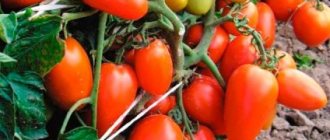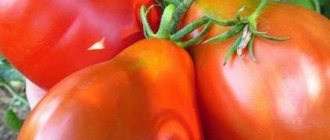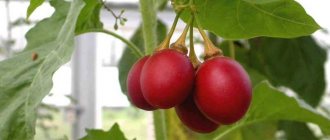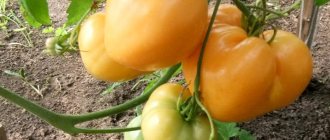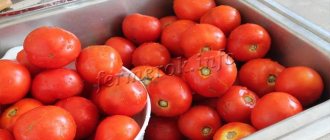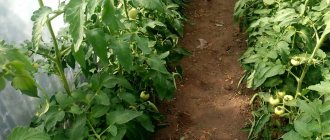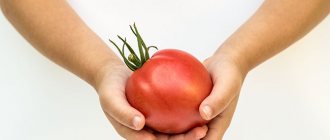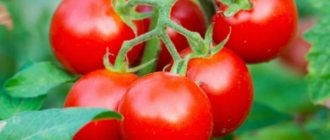Description of the tomato variety Parsley gardener
The variety was obtained by breeder V.N. Dederko and officially entered into the Russian register in 2013. The Parsley gardener tomato belongs to the mid-early species; the harvest ripens in 110-115 days. The bushes are standard, low, up to 60 cm, but in closed ground they can grow up to a meter in height. The bushes are very dense, with an abundance of twigs, flowers, and ovaries. The leaves are large, powerful, dark green in color.
The pulp is dark pink, more granular, with a low juice content
The fruits are deep pink when ripe. The shape is oblong, the ribs are noticeable. The weight of one tomato can range from 150 to 200 g on average. The taste is excellent, sweet, due to the high sugar content. The pulp is dark pink, more granular, with a low juice content. The seeds are normal size, yellow. The peel is thin, but you can eat it.
Important!
Gardener Parsley tomatoes have little juice, so it is better to eat them fresh or make delicious dressings and sauces. And for the preparation of tomato juice, more juicy varieties are selected.
Flaws
This variety of tomatoes has no serious disadvantages. It is only necessary to comply with the rules and conditions for growing this vegetable crop at all stages of its development, as well as further caring for the bushes. If all these rules are not followed, the yield of the variety can be sharply reduced.
This is interesting! Find out about these varieties of tomatoes: tomato “Sanka”, tomato “Katya f1”, tomato “Ladies’ Man”, tomato “Geranium Kiss”.
Characteristics of the Parsley tomato gardener
Also check out these articles
- Wax moth (bee moth)
- Cochin chicken breed
- What to feed ducks in winter?
- Radish Zhara description and characteristics of the variety
The advantages and disadvantages of the Parsley gardener tomato are presented in the characteristics of the variety.
- The bushes no longer grow high, but wide. Thanks to this, they are easy to care for and do not require a high trellis.
- The variety is suitable for cultivation in open and closed ground.
- Propagation by cuttings is possible.
- Extended period of active fruiting, namely from July to October.
- Developed immunity to apical and root rot and late blight. The plant is the last to be affected by these diseases in the area.
The bushes no longer grow high, but wide
- The yield from one bush is 4-6 kg, which is considered a very high indicator.
- Fruits can be stored fresh for a long time after picking if they are whole and not damaged.
- The tomatoes are very beautiful, have commercial quality and are suitable for transportation.
- When fully ripe there is a risk of cracking.
- Growing this variety can be problematic for beginning gardeners.
Diseases and pests
Despite the fact that the hybrid is resistant to most diseases, it is susceptible to blossom end rot, fusarium, and cladosporiosis if poorly cared for and in unfavorable weather conditions. If a problem is detected, remove the damaged parts of the bush and treat with special preparations.
In cool summers, preventive treatment against fungal diseases with preparations containing copper will be required. If tomatoes are grown in a greenhouse, it is necessary to ventilate the greenhouse daily.
The moist and warm environment of the greenhouse is favorable for pathogenic organisms, and the flow of air reduces the growth and development of pathogens.
Treatment with special preparations and insecticides, as well as spraying the bushes with folk remedies based on celandine decoctions, garlic and onion infusions, can help with pests.
When working with insecticides, be sure to be careful, follow the instructions and advice written on the packaging, and carry out the treatment before the flowering period begins. To avoid infection with diseases of nightshade crops, crop rotation is used on the site
Tomatoes have not been planted in the same bed for years, you need to change the place of growth, avoid growing after nightshade crops: potatoes, eggplants, peppers. Since plants of the nightshade family are susceptible to certain diseases. You should avoid being near them.
Tomatoes feel good in the garden after cucumbers, zucchini, onions, cabbage, herbs, carrots, beets, legumes, and grain crops.
Disinfecting and fertilizing the soil every year will reduce the likelihood of disease infection and pest proliferation. It is recommended to remove the top layer of soil in the garden bed or greenhouse.
The thickness of the removed layer is 15-20 cm. It is in this layer that insects leave their larvae for the winter, and there may be pathogens on the surface.
The remaining soil is watered with a solution based on copper sulfate or a hot dark crimson solution of potassium permanganate. Digging the soil allows you to control the development of pests. The application of fertilizers containing calcium helps to increase the resistance of tomatoes to blossom end rot.
Features of growing seedlings
The Parsley gardener tomato variety is grown using the seedling method. Seeds are sown around mid-February or early March (60 days before transplanting to a permanent location). Before sowing, the seeds are soaked in a manganese solution (if they are not treated with anything). Sowing is carried out in special containers. It is better to take soil for seedlings. It must be drained, light, but nutritious. The depth of seed placement is up to 1.5 cm or less. Furrows for seedlings are made at intervals of 2 cm. A distance of 1.5-3 cm is maintained between seeds.
After sowing, the seeds are sprinkled with earth, the soil is sprayed with a spray bottle with small holes so that the earth is not washed out. Then you need to cover the container with film. The container with seedlings should be kept in a warm room, then the first shoots can be observed after 4-5 days.
Gardener Parsley tomato seedlings grow low and strong, quickly grow foliage
Interesting!
Parsley tomatoes are distinguished by the fact that they can be propagated by cuttings! If there are several healthy bushes, cuttings are simply taken from them and planted in a nutrient substrate. They usually grow roots quickly.
When the seedlings hatch, the container with the sprouts is transferred to a room with a temperature of about +18 degrees. Gardener Parsley tomato seedlings grow low and strong, quickly grow foliage, so after two leaves appear, it is necessary to plant the sprouts in separate cups.
2 weeks before planting in a permanent place, seedlings need to be hardened off. At first, they are taken out into the open air or balcony for half an hour, then brought into the house. Every day you need to increase the time the sprouts stay outside by a quarter of an hour. In this case, it will be much easier for the seedlings to take root in a new place.
Growing and caring for crops
To get a good harvest, you must follow special recommendations, starting with planting seeds and growing seedlings. If the purchased seeds have not been disinfected with a fungicide, it is recommended to treat them yourself with a weak solution of potassium permanganate. To do this, the planting material is wrapped in gauze and immersed in the prepared solution for 15-20 minutes.
Advice! Since the variety is mid-season, the seeds should be sown 130-125 days before the expected harvest.
Tomato seeds are small
For rapid germination of planting material, it is recommended to pre-germinate it. The procedure will be as follows:
- The seeds are evenly laid out on the surface of a cotton cloth (you can replace it with gauze or a napkin).
- Cover with the second half of the fabric.
- For best results, place in a plastic bag.
- They are sent to the battery or any other warm place.
Advice! It is necessary to check that the fabric is damp. The first shoots can be observed on the 5-6th day.
Growing and planting seedlings
Before you start planting germinated seeds, you need to prepare the soil. It is thoroughly disinfected in the oven or by spilling it with a solution of potassium permanganate.
Features of planting the Parsley gardener variety
We recommend reading our other articles
- Victoria turkeys - maintenance tips
- Premixes for pigs
- Sprouting potatoes
- Kalmyk breed of cows
You can grow Parsley gardener tomatoes in open or closed ground. If open ground is chosen, then a place is chosen that is illuminated and windless. Planting is carried out when a stable temperature of about +15 degrees is established, and the ground warms up to +10 degrees. During planting, the site is dug up and leveled; you can apply fertilizer directly to the soil during digging or in each hole separately. Per square meter of area take 10 g of ammonium nitrate, 40 g of superphosphate, 15 g of potassium sulfate.
You can grow Parsley gardener tomatoes in open or closed ground
Planting is best done in the early morning or late afternoon. The holes are initially watered abundantly. The seedlings are transferred to the holes using the transshipment method and covered with earth. A distance of 50 cm is maintained between sprouts.
Interesting!
It is advisable to plant plants up to the first leaves, at an angle, then the root system will be more powerful.
Planting and propagation
It is recommended to grow these tomatoes in seedlings. Seed material should be planted in the last ten days of February or the first ten days of March.
It is better to purchase soil for planting in a specialized store, but you can also prepare it at home from garden soil, peat and river sand, taken in equal proportions.
The nutrient substrate, prepared independently, should be calcined in the oven or spilled with a weak solution of potassium permanganate for disinfection.
Packaging options for tomato seeds “Parsley-gardener”
Seedlings are picked after the seedlings have at least 2-3 true leaves. The seedlings tolerate this procedure well, quickly adapt after transplantation and grow well.
During the growing of seedlings, they are usually fed twice - the first time two weeks after picking, and the second time 10-12 days before transplanting the plants to a permanent place. Fertilizers with a high nitrogen content are used as such fertilizers so that the seedlings quickly increase their vegetative mass.
Watering the seedlings is done as the top layer of soil dries. At the same time, you should not allow stagnation of moisture in the soil, otherwise young plants may be affected by blackleg.
Another feature of this tomato is the ability to propagate bushes by cuttings. Usually, stepsons or shoot tips are used for this, which need to be placed in water until roots form.
Then they can be transplanted to a permanent place. Thus, even with a small number of seedlings, cuttings can be used to constantly increase the number of Parsley gardener bushes throughout the season, thereby increasing the fruiting period of this vegetable crop.
Several bushes of this tomato can be planted in a container and left indoors for the winter. At the same time, you can pick ripening fruits all winter, and by spring you can pick large mature bushes.
How to care for tomatoes
If the gardener planted tomato seedlings of the Parsley variety in unprotected soil early, they may freeze during return frosts. To protect it from this, a film cover is made, because even a temperature of +1 degree is destructive for seedlings. Otherwise, caring for plants is almost the same as for other types of tomatoes. But you need to follow all care measures, otherwise the quality of the bushes, fruits or the taste of the tomatoes may disappoint.
- Watering is carried out in the early morning or evening. Daytime watering is only possible if there is a drip system. Watering is carried out approximately once every 3-5 days, depending on the type of soil and weather conditions. In particularly dry times, you can do them every day.
- As they appear, you need to pull out the weeds by the roots and burn them outside the site or put them in a compost heap.
- Loosening the soil is necessary after adding water or rain.
- Fertilizing for active growth of the bush is carried out throughout the growing season. 2 weeks after planting the crop, you can fertilize it with ammonium nitrate. The remaining fertilizing is applied at intervals of 2-2.5 weeks. For this purpose, complex mineral mixtures with an abundance of phosphorus and potassium are used.
If the flowers begin to fall off before blooming, you need to treat the bushes with a solution of boric acid
Interesting!
In order for tomatoes to ripen better in cloudy weather, you need to frequently add potassium. And in sunny weather, the amount of potassium in fertilizing is reduced.
- Mulching is not practiced by many gardeners, but it effectively helps retain moisture in the soil. To reduce watering, you can use simple mulch, spread under the bushes and between the rows. In addition, mulch inhibits the growth and development of weeds.
- If the flowers begin to fall off before blooming, you need to treat the bushes with a solution of boric acid.
- During the development of the bush, it is important to provide support for the branches. The plant grows strongly in width, and not in height, so it is advisable to make a low, but stable support for the plant.
- The Parsley tomato gardener can produce fruits right up to frost, but in order for them to ripen by the first frost, you need to reduce watering in the fall.
Interesting!
Gardeners note that gardener's Parsley tomato seedlings almost never stretch, have a developed root system and are highly resistant.
Let's start with the characteristics
The bushes are strong, erect, do not form a large number of shoots, medium-sized leaves of a dark green color. The inflorescences are simple. During the season, 5-7 ovaries with 6-8 tomatoes on each are formed. Regular removal of the shoots is not required; when replanting, you can remove the lower leaves and shoots up to the first flower cluster.
It may be necessary to fix it to supports so that the bush does not fall to the ground under the weight of the ripening crop and the tomatoes do not begin to rot. The Parsley variety needs good ventilation and plenty of sunlight. It is necessary to select a well-lit, ventilated area.
Beautiful bright red fruits are small in size and elongated in shape. The average fruit weight of the variety is 150-180 grams. Tomatoes have a good taste, which harmoniously combines sweetness and pleasant sourness.
The sugary, juicy pulp contains a high percentage of sugars and nutrients. Tomatoes have universal uses. The harvest will ripen 110-120 days after germination. The bush bears fruit for a long time from mid-summer to October.
The variety is a hybrid, so the seeds cannot be used for sowing next year; they will not give the same results. The fruits will not have the same characteristics.
The tomato is unpretentious in care. The variety is immune to tomato diseases; it is enough to follow the watering regime and standard agricultural practices to get a bountiful harvest.
Harvesting and processing
Gardeners advise planting the harvest in its entirety.
The harvest usually begins in July. The fruits are collected as they ripen. After harvesting, tomatoes can last for about 1-1.5 weeks without deterioration in appearance or taste.
Gardeners advise planting the harvest whole, or in pieces for the winter. These tomatoes also make delicious sauces and dressings. These tomatoes are very tasty just fresh; they are used to prepare fresh salads and snacks. You can make tomato paste for borscht from the fruits, but it is better not to make tomato juice from them - due to the low juice content, this is impractical.
Important!
Many gardeners complain that after full ripening the fruits crack. As a result, their shelf life is reduced, and such tomatoes cannot be called marketable.
Diseases and pests
Strong immunity is the highlight of the Parsley Ogorodnik variety; tomatoes rarely become infected and suffer from diseases such as:
- fusarium;
- cladosporiosis;
- spotting.
During a fungal epidemic, late blight is feared and preventive measures are taken. Irrigate the bushes with copper-based preparations - copper sulfate and Bordeaux mixture. In case of severe symptoms – the presence of brown spots, the shoots are treated with “Ridomil Gold” or “Fundazol”.
When infected with septoria or alternaria, use Metaxil.
Expert opinion
Valentina Rareko
Editor-in-Chief of Repka.online. Experienced summer resident and gardener.
The gardener tomato Parsley is liked by everyone who has ever tried to plant this variety. Many farmers note such advantages as stable yields, excellent taste, and high marketability. The fruits make delicious preparations for the winter - assorted dishes, juices, pastes, ketchups.
Reviews of the tomato variety Parsley gardener
The opinion of gardeners about the Parsley gardener tomato variety can be read below.
- Kristina Frolova : “I tried to grow this variety 3 years ago and now I can’t do without it at all! Yes, in some moments the manufacturer exaggerates the quality of the tomatoes too much, but they are still more than good! I planted them both in a greenhouse and in open ground, but in the latter case it is easier to grow them because they grow very short. The bushes develop quickly and produce more than enough fruit for food and preservation. The only important drawback is that some tomatoes crack. Otherwise there are no problems."
- Makar Kiselev : “The gardener heard a lot of good things about the Parsley tomato, but personally the variety disappointed me. Last year I planted several bushes in a greenhouse - the bushes grew large, the yield was average. And the tomatoes themselves are inferior to many other types, both in appearance and in taste. So the variety may be good for some, but I believe that there are many more worthy contenders among the new species.”
- Sofia Sirotkina : “Two years ago I bought 3 bushes of seedlings of these tomatoes. I grew it in open ground and I can say that the variety has both advantages and disadvantages. The bushes are productive and do not require care. At the same time, the taste of the tomatoes is good, but I lack juice. The disadvantage is that the fruits crack and rot quickly because of this. In addition, the bushes grow dense, and many fruits literally get stuck between the branches - this moment needs to be controlled!”
Advantages and disadvantages, features, differences from other varieties
There are currently so many varieties and hybrids of tomatoes that when choosing you have to pay attention to all the nuances. Thus, the very fact that the State Register of the Russian Federation says about the Parsley Gardener variety that its fruits have a good taste can be alarming: after all, there are many varieties whose fruit taste is described as excellent. What interested gardeners who think that this variety is very good? It actually has a number of advantages, for example:
- long fruiting;
- drought resistance;
- adaptability to changing weather conditions;
- ease of handling bushes (many gardeners don’t even plant them);
- versatility of using tomatoes;
- good transportability and preservation of the crop;
- interesting appearance of the fruit;
- high disease resistance.
Among the disadvantages, it is especially noteworthy that when grown in greenhouses, the variety requires artificial pollination. However, it is rarely grown in greenhouses: the gardener’s Petrusha’s bushes are not tall, and in greenhouses they try to save every bit of volume and plant those tomatoes that grow to the ceiling and produce more yield per unit area. In addition, despite the unpretentiousness of care, many note a significant dependence of yield on the correct execution of all conventional agricultural operations.
Probably, among the Siberian varieties of tomatoes, even the collections of the same breeders, Parsley gardener is not the best. So, for example, if we talk about salad use, it would be worth placing slightly higher the cold-resistant variety Velmozha with fleshy, heart-shaped raspberry fruits of excellent taste. True, Velmozhi’s fruits are larger and in their entirety they are not suitable for canning. Other Siberian varieties are much better suited for whole-fruit canning, for example, Zemlyak, which is characterized by a very high yield of plum-shaped, medium-sized tomatoes.
The nobleman is no less cold-hardy than the gardener Parsley, but its fruits are more tasty
The same authors have an excellent large-fruited salad tomato, Babushkin Secret, the taste of the fruits of which is rated as excellent, and the yield is twice as high as that of Parsley Gardener. However, they prefer to grow Grandma’s secret in film greenhouses. The variety of V.N. Dederko is also an excellent tasting tomato, the Siberian Apple, but it grows in the form of a tall indeterminate bush.
Apparently, a distinctive feature of the Parsley gardener variety is the original shape of the fruit, which, together with the crimson coloring, is rare. In terms of other parameters, including consumer properties, it is easy to find analogues for this variety.




